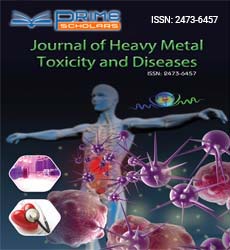Short Communication - (2024) Volume 9, Issue 4
Ecosystem Recovery: Navigating the Impact of Heavy Metal Contamination and Restoration Strategies
Nicola Diol*
Department of Biochemistry, University of Navarra, Spain
*Correspondence:
Nicola Diol,
Department of Biochemistry, University of Navarra,
Spain,
Email:
Received: 31-Jul-2024, Manuscript No. ipjhmct-24-21385;
Editor assigned: 02-Aug-2024, Pre QC No. ipjhmct-24-21385 (PQ);
Reviewed: 16-Aug-2024, QC No. ipjhmct-24-21385;
Revised: 21-Aug-2024, Manuscript No. ipjhmct-24-21385 (R);
Published:
28-Aug-2024, DOI: 10.21767/2473-6457.24.4.31
Introduction
Heavy metal contamination presents a significant threat to
ecosystems, influencing their functions and biodiversity. Metals
such as lead, cadmium, mercury, and arsenic are persistent
pollutants that disrupt ecological balance, impairing soil health,
water quality, and plant and animal life. Addressing these impacts
requires a nuanced understanding of how contamination affects
ecosystems and the development of effective strategies for
ecological restoration.
Description
Heavy metal contamination disrupts various ecosystem functions,
which are the processes and interactions that sustain the health
and productivity of an ecosystem. These functions include nutrient
cycling, primary production, soil formation, and decomposition.
Heavy metals can interfere with nutrient availability and uptake.
For example, metals like cadmium and lead can compete with
essential nutrients for uptake by plants, leading to nutrient
deficiencies and reduced plant growth. This, in turn, affects
herbivores that depend on plants for food and disrupts the entire
food web. Plants are at the base of the food web, and their ability
to photosynthesize and grow is crucial for primary production.
Heavy metals can inhibit photosynthesis by damaging chlorophyll
and other cellular components. Reduced plant growth decreases
primary production, impacting herbivores and higher trophic
levels. Heavy metal contamination can alter soil properties by
affecting soil microorganisms responsible for soil formation and
fertility. For instance, metals can be toxic to beneficial microbes
that decompose organic matter and contribute to soil structure.
This disruption impairs soil health, affecting plant growth and
nutrient availability. The decomposition process, driven by soil
microbes and invertebrates, is essential for nutrient recycling.
Heavy metals can inhibit microbial activity, slowing down
decomposition rates and leading to the accumulation of organic
matter. This can further exacerbate nutrient imbalances in the
soil. Soil and aquatic microorganisms are highly sensitive to
heavy metal pollution. Metals can alter microbial community
composition and reduce microbial diversity. This loss of microbial
diversity can impair essential ecological processes, such as
nutrient cycling and organic matter decomposition. Heavy metal
stress can lead to decreased plant diversity. Some plants may
be more tolerant to metal contamination, while others may be
highly sensitive. Over time, the differential survival and growth
of plants lead to a shift in plant community composition, often
resulting in reduced overall biodiversity. Animals, including
insects, birds, and mammals, can be directly affected by heavy
metals through ingestion or absorption. Chronic exposure can
lead to reproductive issues, reduced immune function, and
increased mortality rates. This impacts animal populations
and can lead to cascading effects throughout the ecosystem.
Restoring ecosystems affected by heavy metal contamination
requires a multifaceted approach that addresses the source
of pollution, mitigates its effects, and promotes recovery. The
addition of soil amendments, such as lime, phosphate, or organic
matter, can alter the chemical forms of heavy metals, making
them less bioavailable. This reduces metal uptake by plants and
mitigates toxicity [1-4].
Conclusion
Heavy metal contamination poses serious challenges to
ecosystem functions and biodiversity. Understanding the impacts
on nutrient cycling, primary production, and biodiversity is crucial
for developing effective restoration strategies. By employing
techniques such as soil amendments, phytoremediation, and
bioremediation, and by involving communities in restoration
efforts, we can work towards recovering and sustaining healthy
ecosystems in the face of heavy metal pollution. Ongoing
research and innovation in these areas will be key to addressing
the long-term challenges of ecosystem recovery and ensuring resilient and functioning environments for future generations.
Acknowledgement
None.
Conflict Of Interest
The author states there is no conflict of interest.
References
- Bourgeois C, Alfaro AC, Bisson E (2020) Trace metal dynamics in soils and plants along intertidal gradients in semi arid mangroves. Mar Pollut Bull. 156(2):111274.
[Crossref] [Google Scholar]
- Bray JR, Curtis JT (2000) An ordination of the upland forest communities of Southern Wisconsin. Ecol Monogr. 27(4):325-349.
[Crossref] [Google Scholar]
- Caporaso JG, Kuczynski J, Bittinger K (2010) QIIME allows analysis of high throughput community sequencing data. Nat Methods. 7(5):335-336.
[Crossref] [Google Scholar]
- Chen Y, Jiang Y, Huang H (2018) Long term and high concentration heavy metal contamination strongly influences the microbiome and functional genes in yellow river sediments. Sci Total Environ. 25(1):637-638.
[Crossref] [Google Scholar]
Citation: Diol N (2024) Ecosystem Recovery: Navigating the Impact of Heavy Metal Contamination and Restoration Strategies. J Heavy Met Toxicity Dis. 09:31.
Copyright: © 2024 Diol N. This is an open-access article distributed under the terms of the Creative Commons Attribution License, which permits unrestricted use, distribution, and reproduction in any medium, provided the original author and source are credited.

